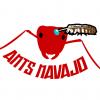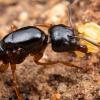Ants siphon liquid sugar with sand grains based on surface tension of the liquid so as to avoid drowning: https://www.sciencen...ol-death-safety
Us antkeepers have know this for awhile and now its science news: https://besjournals....1365-2435.13671
- Ants are among a few invertebrates that can use certain tools. For example, some ants can use debris and soil grains to transport liquid food. Although there has been evidence showing that ants can select the most efficient tools in transporting liquid food, little is known about their flexibility in using a specific tool under environmental pressure.
- Black imported fire ants Solenopsis richteri Forel, can use sand grains as a tool for foraging. We hypothesized that S. richteri can adjust their strategy of tool use in response to various foraging risks. The hypothesis was tested by studying their sand use behaviour in response to sugar water with different drowning risks.
- The results support our hypothesis. Solenopsis richteri indeed adjusted their strategy of tool use in response to increased drowning risks. Due to their hydrophobic cuticle, S. richteri can float on water surface to forage directly with the minimal risk of drowning. However, when the drowning risk was elevated by reducing the surface tension of sugar water in a food container by the addition of surfactant, ants used sand grains to build a structure that could effectively function as a syphon instead of directly foraging inside the container. This sand structure could draw sugar water out of the container then to be collected by the ants, which not only reduced the drowning risk of ants, but also provided a larger operational space for their collection of sugar water.
- This study demonstrates that ants can not only recognize the increase in foraging risks, but also make corresponding adjustments to their strategy by using a specific tool. Our results also suggest that social insects can be highly flexible in their tool use in response to ecological challenges.



















